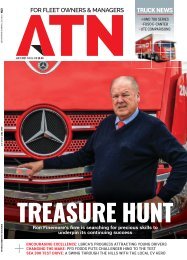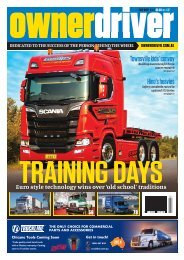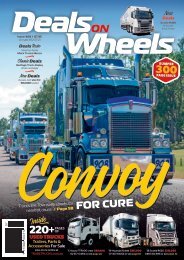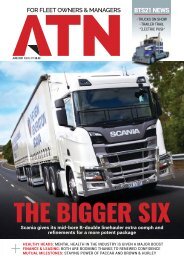Farms & Farm Machinery #401
Create successful ePaper yourself
Turn your PDF publications into a flip-book with our unique Google optimized e-Paper software.
Harvesters<br />
Victoria’s Grain Harvest Management Scheme<br />
saw improvements in compliance with mass<br />
limits when transporting grain<br />
Well stocked<br />
Grain trucks were more compliant with mass limits in Victoria during the last harvest<br />
season despite a significant increase in total yield, according to a new report<br />
Breaches fell 1.6 per<br />
cent to 16.9 per cent<br />
of all deliveries in<br />
2020–21<br />
A scheme to help grain truck drivers load their<br />
vehicles more accurately saved more than 8,000<br />
trips over a substantially stronger harvest season.<br />
The 2020-21 Harvest Period Report into Victoria’s<br />
Grain Harvest Management Scheme (GHMS),<br />
released in July by the National Heavy Vehicle<br />
Regulator (NHVR), showed strong improvements in<br />
compliance.<br />
The GHMS was designed in response to industry<br />
calls that protested the difficulty many have with<br />
heavy vehicle mass limits when loading grain for<br />
transport.<br />
Uncertainties around the changing density and<br />
mass of grains and other crops when being transported<br />
can create difficulties during the process of<br />
loading trucks with grain before they are sent to a<br />
grain receiver.<br />
First launched four years ago, the GHMS allows<br />
scheme-registered vehicles an extra mass allowance<br />
of up to 5 per cent above the statutory general<br />
mass limit for vehicles when delivering grain to a<br />
participating grain receiver.<br />
According to VicRoads, the scheme allows for an<br />
efficient grain harvest while helping to eliminate<br />
overloading on road systems.<br />
The report, which is based on data provided to<br />
the NHVR by participating grain receivers Emerald<br />
Grain, Viterra, CHS Broadbent, GrainFlow, Ridley<br />
Agriproducts, GrainCorp and Teys, says a total of<br />
7,048 vehicles delivered grain to these facilities<br />
during the last harvest season.<br />
Interest in the scheme has grown year on year,<br />
with a 32.6 per cent rise in participating vehicles<br />
in 2020–21, with 399 vehicles participating in<br />
the scheme and 18,522 deliveries made by those<br />
vehicles.<br />
While the GHMS vehicles only represented 5.6 per<br />
cent of all vehicles used to deliver grain, the report<br />
says vehicles registered under the scheme made<br />
more trips to grain facilities, transporting 9.8 per<br />
cent of all grain delivered.<br />
Covering the period from 1 October 2020 to 21<br />
May 2021, the most recent GHMS report shows<br />
that, despite an increase of 25 per cent in Victoria’s<br />
total harvest size to 5.2 million tonnes, the number<br />
of mass limit breaches were the lowest recorded<br />
under the scheme to date.<br />
According to the report, the number of total<br />
breaches fell 1.6 per cent to 16.9 per cent of all deliveries<br />
in 2020–21; an improvement on the previous<br />
year, when 18.44 per cent of all deliveries were in<br />
breach.<br />
Most breaches of the legal weight limits were by<br />
under one tonne, with the report saying extreme<br />
mass breaches (of over three tonnes) had reduced<br />
to 2.5 per cent in 2020–21, compared to 3.3 per cent<br />
the year before.<br />
For vehicles registered under the GHMS, the rate<br />
of non-compliance had dropped significantly, to<br />
9.35 per cent of all vehicles in 2020–21 – compared<br />
to 25.16 per cent in 2019-20.<br />
Of the total deliveries made in Victoria in 2020–21,<br />
57.36 per cent were made in a vehicle loaded within<br />
95 per cent of its allowable mass limit – a figure<br />
that actually drops to 54.46 per cent among GHMS<br />
participants.<br />
Nonetheless, with the GHMS weight allowance,<br />
alongside concessional mass limits, higher mass<br />
limits, performance-based standards and other<br />
concession types, a total of 8,524 trips were saved in<br />
2020–21 – an improvement on the 6,661 trips saved<br />
the previous year.<br />
Applications open in September for companies<br />
wishing to participate in the scheme for the coming<br />
harvest season, but parties wishing to join the<br />
scheme must own a vehicle manufactured on or<br />
after January 1, 2002, and be delivering grain to a<br />
participating receiver.<br />
ON THE ROAD<br />
According to the report, the most common vehicle<br />
type reported delivering grain to receiver facilities<br />
were prime mover and semi-trailer combinations<br />
with six axles, followed by B-double vehicles.<br />
The average year of manufacture for the fleet<br />
completing the grain transport task has increased<br />
from 1982 to 1995 since the introduction of the<br />
Scheme four years ago, with the median year of<br />
manufacture now sitting at 2003.<br />
The number of vehicles that are over 40 years old<br />
delivering grain has also dropped significantly in<br />
the last four seasons, the report says.<br />
The findings come as the NHVR launches a new<br />
campaign to encourage road users to give agricultural<br />
vehicles extra space on the road ahead of this<br />
year’s planting and harvest season.<br />
NHVR chief executive Sal Petroccitto said the<br />
recent increase in Australians moving to regional<br />
communities in the past year meant more traffic<br />
for agricultural vehicle drivers to safely navigate<br />
during the up-coming harvest.<br />
“We know up to four out of five crashes involving<br />
a heavy vehicle are caused by light vehicle drivers,<br />
so it’s important motorists understand how to<br />
safely share the road with heavy vehicles,” says<br />
Petroccitto.<br />
“Tractors, grain harvesters and air seeders all<br />
have limited turning ability, visibility of other vehicles,<br />
speed range and space on our roads.<br />
“If you’re travelling near an agricultural vehicle,<br />
please be patient, reduce your speed, maintain a<br />
safe following distance of two seconds or more, and<br />
only overtake if it is safe to do so.<br />
The NHVR has launched a new website with information<br />
about sharing the road safely with heavy<br />
vehicles – www.weneedspace.com.au – which had<br />
a video and information package encouraging<br />
drivers not to overtake turning trucks at the time of<br />
going to press.<br />
“If an oversized ag vehicle is approaching you<br />
from the opposite direction, you may need to pull<br />
over safely to let them pass,” says Petroccitto.<br />
“It’s these simple tips that will help reduce risk for<br />
all road users and ensure everyone arrives safely at<br />
their destination – whether it’s to the silo, stockyard<br />
or home.”<br />
54 <strong><strong>Farm</strong>s</strong> & <strong>Farm</strong> <strong>Machinery</strong>
















